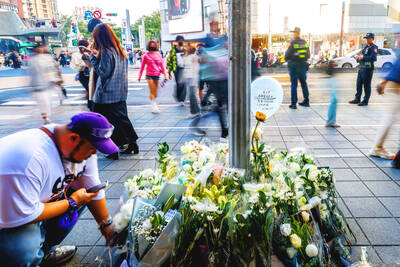An inscription found in the tomb of Zhu Yihai (朱以海, 1618-1662), Prince of Lu during the Ming Dynasty, is on display at the Historical Folk Museum in Kinmen County.
The inscription, which was carved into a tombstone and buried with Zhu shortly after his death in the county in 1662, was discovered during construction work in 1959 and transferred to the National Museum of History in Taipei.
The 726-character inscription records Zhu’s visits with civilian officials and militia generals in China’s Zhejiang, Fujian and Guangdong provinces after the fall of the Ming Dynasty in 1644.
Zhu and three other princes led resistance movements — called the Southern Ming — against the military of the Manchu Qing Dynasty.
At the official opening of the exhibition on Friday last week, former National Museum of History director Chang Yui-tan (張譽騰) said he is glad to see the inscription returned to Kinmen for the exhibition and hopes the county would become a center for Southern Ming studies.
Since the inscription is to return to Taipei after the exhibition, a 3D-printed replica was made and presented to county government, National Museum of History director Chen Teng-chin (陳登欽) said.
The exhibition is significant as culture from both Minnan (Southern Fujian Province) and the Southern Ming enable the county to act as a bridge between Taiwan and China, County Secretary-General Lin De-gong (林德恭) said.
The inscription also says that Zhu died of asthma on Kinmen and not at sea on the orders of Koxinga (Cheng Cheng-kung, 鄭成功) as recorded in the dynastic history of the Ming, indicating that Zhu had died about six months after Koxinga’s death.
The exhibition is part of activities to mark the 400th anniversary of Zhu’s birth and is to run until Aug. 30.

SHIPS, TRAINS AND AUTOMOBILES: The ministry has announced changes to varied transportation industries taking effect soon, with a number of effects for passengers Beginning next month, the post office is canceling signature upon delivery and written inquiry services for international registered small packets in accordance with the new policy of the Universal Postal Union, the Ministry of Transportation and Communications said yesterday. The new policy does not apply to packets that are to be delivered to China, the ministry said. Senders of international registered small packets would receive a NT$10 rebate on postage if the packets are sent from Jan. 1 to March 31, it added. The ministry said that three other policies are also scheduled to take effect next month. International cruise ship operators

HORROR STORIES: One victim recounted not realizing they had been stabbed and seeing people bleeding, while another recalled breaking down in tears after fleeing A man on Friday died after he tried to fight the knife-wielding suspect who went on a stabbing spree near two of Taipei’s busiest metro stations, Taipei Mayor Chiang Wan-an (蔣萬安) said. The 57-year-old man, identified by his family name, Yu (余), encountered the suspect at Exit M7 of Taipei Main Station and immediately tried to stop him, but was fatally wounded and later died, Chiang said, calling the incident “heartbreaking.” Yu’s family would receive at least NT$5 million (US$158,584) in compensation through the Taipei Rapid Transit Corp’s (TRTC) insurance coverage, he said after convening an emergency security response meeting yesterday morning. National

PLANNED: The suspect visited the crime scene before the killings, seeking information on how to access the roof, and had extensively researched a 2014 stabbing incident The suspect in a stabbing attack that killed three people and injured 11 in Taipei on Friday had planned the assault and set fires at other locations earlier in the day, law enforcement officials said yesterday. National Police Agency (NPA) Director-General Chang Jung-hsin (張榮興) said the suspect, a 27-year-old man named Chang Wen (張文), began the attacks at 3:40pm, first setting off smoke bombs on a road, damaging cars and motorbikes. Earlier, Chang Wen set fire to a rental room where he was staying on Gongyuan Road in Zhongzheng District (中正), Chang Jung-hsin said. The suspect later threw smoke grenades near two exits

The Forestry and Nature Conservation Agency yesterday launched a gift box to market honey “certified by a Formosan black bear” in appreciation of a beekeeper’s amicable interaction with a honey-thieving bear. Beekeeper Chih Ming-chen (池明鎮) in January inspected his bee farm in Hualien County’s Jhuosi Township (卓溪) and found that more than 20 beehives had been destroyed and many hives were eaten, with bear droppings and paw prints near the destroyed hives, the agency said. Chih returned to the farm to move the remaining beehives away that evening when he encountered a Formosan black bear only 20m away, the agency said. The bear